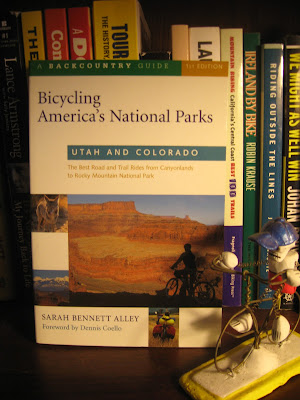From the Library: Bicycling America's National Parks, Utah and Colorado...
Say what? Bicycling in the National Parks? Indeed, and why not? After all, the National Parks were created, in part, to preserve some of the most spectacular scenery in the States, the kind of scenery you want to take your time viewing. Touring them by bike, therefore, must surely beat speeding through in a motor vehicle. Keep in mind that most of the routes you will find available to bikes in our National Parks are along existing roadways, both paved and dirt, but it is not impossible to find rare single track to transport you away from the overcrowded beaten paths as well.
This guidebook includes a selection of routes appropriate for road or mountain bike, and tells you which in bold letters at the head of each section. Each ride also gives starting points, length, surface conditions, difficulty rating, best time to ride info, scenic/cultural highlights, and special considerations. If you have ever visited a National Park you have no doubt noticed roads have generally been built to minimize impacts; in other words they are not very wide, and normally lacking in shoulders. This can make riding in some of the Parks more nerve-wracking than others, especially when you consider that the Parks are visited by 285 million people annually.
As noted in the book's forward, "drive to the Grand Canyon on any summer weekend, and you and six thousand other drivers will spend much of your time competing for the two thousand parking spaces. You have better odds at the local mall." Traveling a Park's roads by bike will allow you to avoid much of the congestion you thought you had left in the city. Though mid-day traffic may be an unfortunate given, even with all these people it is possible to find the solitude of a quiet road; in the past I have written about early morning rides through Kings Canyon (and yes, I know it is outside the scope of this particular book) with nary another soul to disturb the hum of my two wheels. Often, it is all in the timing of the ride. Many National Parks, including some in this book, have been making strides to make the slow biking experience more enjoyable, through the construction of off-roadway paths, limiting motor vehicle access, and even opening dirt roads for extended travel and exploration opportunities. Rides along everything from main roads to paved paths, from dirt roads to rare single track are found in the pages of this book.
Recommended for anyone looking for a different experience of the National Parks located in Colorado and Utah.
Alley, Sarah Bennett Bicycling America's National Parks. Utah and Colorado: The Best Road and Trail Rides from Canyonlands to Rocky Mountain National Park Woodstock, VT: Backcountry Guides, 2000

Comments
Post a Comment